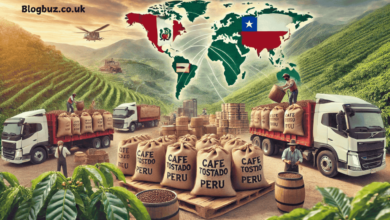Product Sourcing Made Easy: Tips for E-commerce Success

Product sourcing is the process of identifying, evaluating, and obtaining goods or products to sell. It plays a crucial role in shaping the success of businesses, especially for B2B companies and e-commerce sellers. By mastering this process, businesses can enhance profitability, ensure product quality, and build reliable supply chains.
Importance of Product Sourcing
Effective product sourcing helps businesses minimize costs, maintain consistent quality, and respond to market demands. Whether you’re launching a small e-commerce store or managing a large enterprise, strategic for sourcing the product is a cornerstone of sustained growth.
This comprehensive guide will explore the definition and importance of product sourcing, types of sourcing methods, key considerations, challenges, tips for success, and emerging trends in 2025. By the end, you will have actionable insights to refine your sourcing strategy.
What Is Product Sourcing?
Product sourcing refers to the process businesses use to acquire the goods they sell. It’s a critical element of the supply chain, ensuring businesses have the right products at the right time. Whether it involves working with local suppliers, international manufacturers, or leveraging dropshipping models, sourcing strategies vary based on business needs and goals.
Why Is Product Sourcing Important?
- Cost-Effectiveness: Strategic sourcing can reduce production and logistics costs, boosting profitability.
- Ensuring Product Quality: Reliable sourcing ensures consistent product quality, a key factor for customer satisfaction.
- Building Strong Supplier Relationships: Strong relationships with suppliers pave the way for better pricing, priority service, and long-term partnerships.
The Role of China in Global Product Sourcing
China is a major hub for sourcing the product due to its manufacturing capacity, competitive pricing, and diverse range of goods. Many businesses rely on a China sourcing agent or China buying agent to navigate the complexities of working with suppliers in China. These agents offer expertise in supplier negotiation, quality assurance, and logistics.
Types of Sourcing The Product
Direct Sourcing
Direct sourcing involves procuring products directly from manufacturers or producers. This method ensures greater control over product quality and customization.
Benefits:
- Cost savings from reduced middlemen.
- Enhanced customization options.
Challenges:
- Requires significant investment in supplier relationships and logistics management.
- Potential for higher upfront costs.
Dropshipping
Dropshipping allows businesses to sell products without holding inventory. The supplier ships products directly to the customer.
Pros:
- Low upfront investment.
- Minimal risk for inventory management.
Cons:
- Limited control over product quality and shipping timelines.
- Dependence on supplier reliability.
Wholesalers
Wholesalers sell goods in bulk at discounted prices, making them an attractive option for small and medium-sized businesses.
Benefits:
- Access to a wide range of products.
- Economies of scale reduce per-unit costs.
Manufacturers
Sourcing directly from manufacturers enables businesses to customize products and negotiate better pricing.
Considerations:
- Manufacturers often require larger minimum order quantities.
- Building trust and reliability takes time.
Online Marketplaces
Platforms like Alibaba, Amazon, and Etsy provide vast sourcing options for businesses.
Tips:
- Vet suppliers through reviews and ratings.
- Start with small orders to test reliability and product quality.
Third-Party Fulfillment Services
Using 3rd party fulfillment services streamlines operations by outsourcing storage, packaging, and shipping.
Benefits:
- Reduces logistical complexities.
- Ensures faster delivery times.
Challenges:
- Additional costs for service providers.
- Limited control over order fulfillment processes.
How to Start Product Sourcing
Research and Planning
Understand your target audience, identify market trends, and determine which products align with your business goals. Thorough research helps you avoid costly mistakes and ensures that your sourcing strategy supports your long-term objectives.
Finding Reliable Suppliers
Search for suppliers through trade directories, online platforms, and industry networks. Be vigilant for red flags such as inconsistent communication or lack of certifications. Hiring a China sourcing service can be beneficial for businesses targeting international markets.
Negotiating with Suppliers
Effective negotiation strategies include:
- Emphasizing long-term collaboration.
- Requesting bulk discounts.
- Clarifying delivery timelines and payment terms upfront.
Testing Products and Suppliers
Before committing to a supplier, request samples to evaluate product quality. This step minimizes the risk of receiving subpar goods.
Key Factors to Consider
Product Quality
Prioritize quality control to maintain customer satisfaction. Request samples and conduct inspections to ensure standards are met. Investing in third-party inspection services can further enhance quality assurance.
Cost and Pricing
Balance sourcing costs with retail pricing to maximize profits. Be aware of hidden expenses such as shipping fees, customs duties, and taxes.
Shipping and Logistics
Select reliable shipping methods to ensure timely delivery. Consider using international order fulfillment services for efficient global shipping.
Compliance and Legal Requirements
Ensure compliance with local and international regulations, including certifications and import/export laws, to avoid legal complications. Partnering with a China agent can simplify navigating these requirements.
Challenges
Supplier Reliability
Unreliable suppliers can disrupt your operations. Mitigate risks by maintaining a list of backup suppliers and diversifying your sourcing network.
Rising Costs
Inflation and fluctuating material costs can impact profitability. Regularly review and adjust your sourcing strategies to adapt.
Counterfeit Products
Counterfeit goods pose risks to your brand and customer trust. Use reliable sourcing channels and verify suppliers’ authenticity to avoid this issue.
Cultural and Communication Barriers
When sourcing internationally, language and cultural differences can lead to misunderstandings. Relying on a China buying agent or other regional experts can bridge these gaps effectively.
Tips for Successful
- Foster strong supplier relationships through consistent communication and trust.
- Utilize technology such as sourcing platforms and AI tools to streamline operations.
- Stay updated on market trends and adapt to changes proactively.
- Leverage 3rd party fulfillment services to improve delivery efficiency.
Product Sourcing Trends to Watch in 2025
Sustainable Sourcing Practices
Consumers increasingly prefer eco-friendly products. Businesses can focus on sustainability to appeal to this growing demand.
Rise of Local Sourcing
Sourcing locally reduces lead times and shipping costs while supporting regional economies.
AI and Automation
Advanced tools enable efficient supplier selection and market analysis. AI-driven insights help businesses refine their sourcing strategies.
Case Studies and Examples
A small e-commerce business scaled by sourcing directly from manufacturers, achieving higher margins and product customization.
A startup faced delays due to reliance on a single supplier. The lesson: diversify sourcing to mitigate risks.
Conclusion
Product sourcing is the backbone of any successful business. By understanding its nuances, types, and best practices, businesses can achieve cost savings, ensure quality, and build sustainable growth. Start refining your product sourcing strategies today to stay ahead of the competition.
Product sourcing is a cornerstone of business success. By leveraging strategies like working with China sourcing agents, China buying agents, and utilizing 3rd party fulfillment, businesses can overcome challenges, ensure quality, and achieve sustainable growth.
For tailored sourcing solutions, contact Chinadivision today to streamline your product procurement process.




